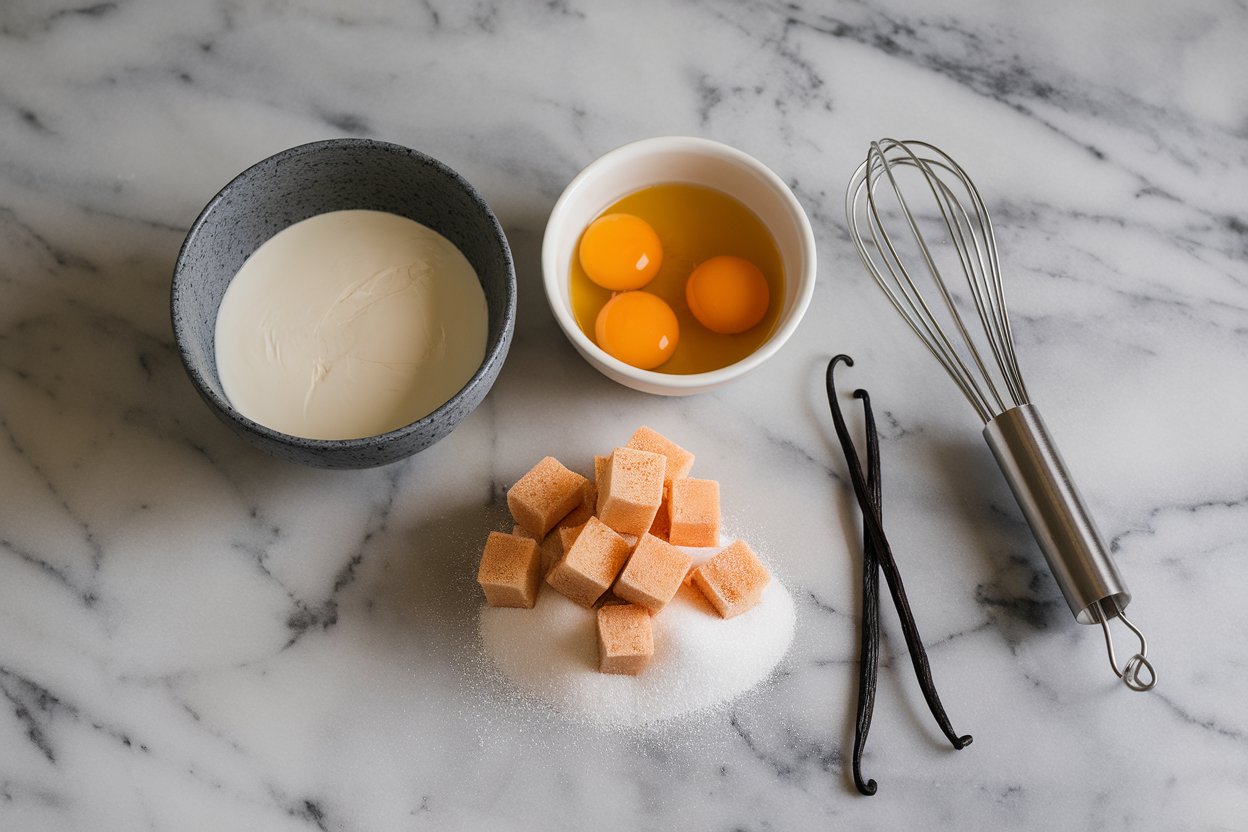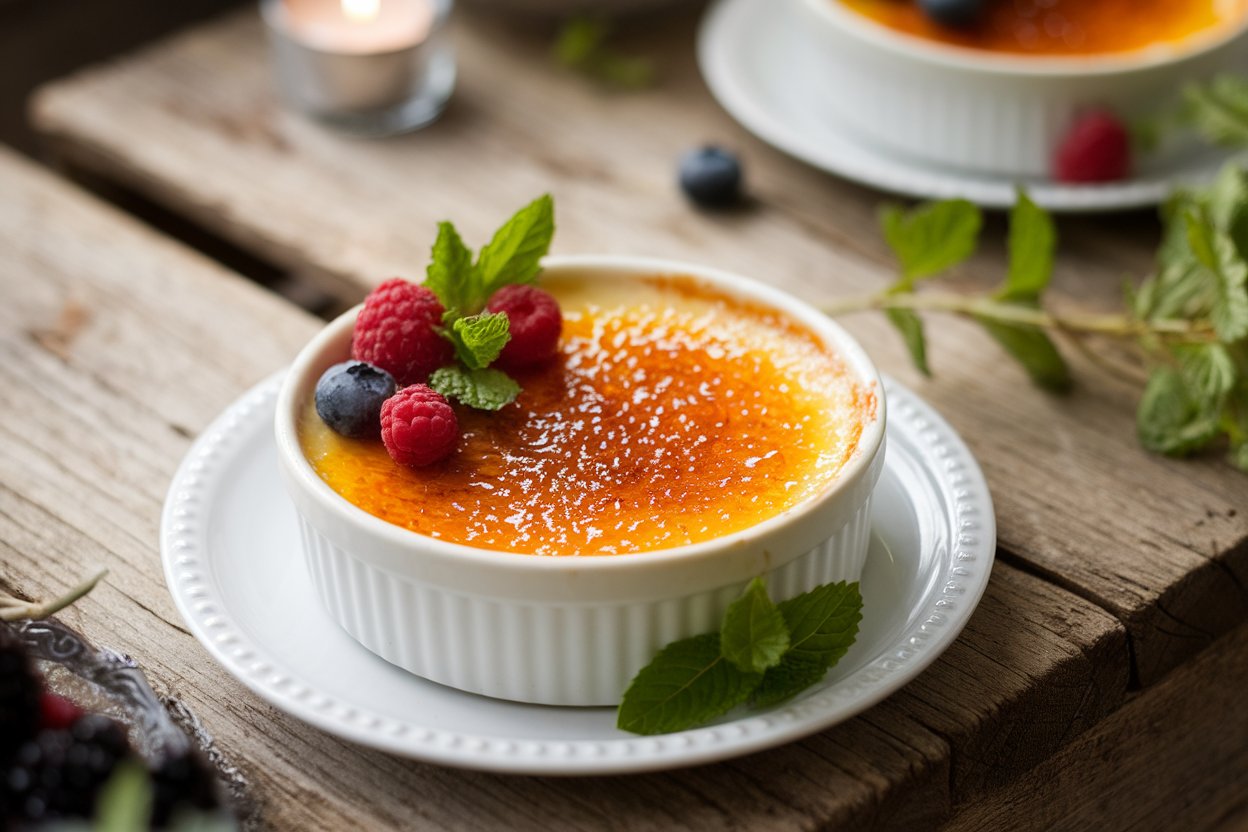Crème brûlée – the name itself sounds so fancy, doesn’t it? This French dessert has been stealing hearts for centuries with its creamy custard base and that satisfying crack of caramelized sugar on top. But what exactly makes crème brûlée so irresistible? Is it the rich vanilla-infused custard or that crispy sugar shell that feels like edible glass? Stick around because we’re about to uncover the secrets behind this iconic dessert!
Table of Contents
The History and Origin of Crème Brûlée
Early Beginnings in Europe
Crème brûlée has a history as rich as its custard. Believe it or not, it’s been argued over by three countries: France, England, and Spain! Each claims they invented it. However, most culinary historians agree that the French version we know today originated in the 17th century.
In fact, there’s a record of a similar dish called “burnt cream” from Cambridge, England, and another version called “crema catalana” from Spain. How cool is it that people all over Europe were basically saying, “Let’s torch sugar and make it amazing”? 🔥
Modern Popularity Across the Globe
Fast forward to today, and crème brûlée is a staple dessert at upscale restaurants worldwide. It’s kind of like the little black dress of desserts—classic, timeless, and always in style. Whether you’re having a fancy dinner out or experimenting in your kitchen, this dessert never fails to impress.
The Anatomy of Crème Brûlée
The Essential Ingredients

Crème brûlée might look like a luxury, but it’s surprisingly simple at its core. You’ll need just five ingredients:
| Ingredient | Quantity |
|---|---|
| Heavy Cream | 2 cups |
| Sugar (Granulated) | ½ cup + extra for topping |
| Egg Yolks | 4 large |
| Vanilla Extract | 1 teaspoon |
| Salt | A pinch |
See? Nothing too exotic. The magic lies in how you bring these simple ingredients together.
The Science Behind the Creamy Texture
Here’s the deal: crème brûlée’s creamy texture comes from the perfect balance of egg yolks and heavy cream. When heated, the proteins in the yolks thicken the cream, creating that silky smooth custard. It’s like the dessert version of a science experiment, but way tastier. 🧪🍮
Secrets to Perfect Crème Brûlée
Choosing High-Quality Ingredients
You know the saying, “You get out what you put in”? It’s never been truer than with crème brûlée. Want the best results? Use high-quality cream and real vanilla extract. Trust me, artificial vanilla is no match for the real deal.
Temperature Control: A Key Factor
Here’s a secret: patience is everything. Baking the custard at a low temperature (around 325°F or 160°C) in a water bath ensures it cooks evenly. Skip the water bath, and you risk turning your custard into scrambled eggs. Yikes! 😱
The Role of Sugar Caramelization
Now, let’s talk about that iconic sugar topping. The key is to use an even layer of sugar and a kitchen torch. The torch melts the sugar, creating a thin, glass-like crust. Don’t have a torch? No worries! Just pop it under a broiler for a similar effect. But be careful not to burn it—it’s a fine line between perfect and “oops.”
“The sugar topping should crack like glass under your spoon—if it bends, you’ve done something wrong!”
Common Problems When Making Crème Brûlée
Why Does the Custard Turn Watery?
If your custard is more like soup than pudding, chances are you didn’t cook it long enough or baked it at too high a temperature. Don’t rush it—crème brûlée is all about the slow game.
How to Avoid a Burnt Sugar Topping
Burning sugar can happen in the blink of an eye. Keep your torch moving in small circles and don’t hover too long in one spot. If you’re using the broiler method, keep a close watch because the sugar can go from golden brown to black faster than you can say “crème brûlée.”
Preventing Air Bubbles in the Custard
Ever notice tiny bubbles in your custard? That’s likely from over-whisking. Be gentle when mixing your ingredients—crème brûlée is delicate, and too much air will mess with its creamy vibe.
Tools and Equipment for Success
Choosing the Right Ramekins
Not all ramekins are created equal. Choose ones that are shallow and wide—this ensures the perfect custard-to-caramel ratio. No one wants to dig through an inch of sugar to get to the good stuff.
The Importance of a Kitchen Torch
Let’s face it: using a kitchen torch makes you feel like a pro. It’s like wielding a mini flamethrower, and it’s the best way to get that crispy sugar topping. If you don’t have one yet, put it on your wish list—it’s a game changer.
Variations of Crème Brûlée
Classic Vanilla Crème Brûlée
You can’t beat the classic. Vanilla crème brûlée is like the original blockbuster that started it all. The flavor is delicate but luxurious, with real vanilla beans giving it those iconic specks. If you’ve never made crème brûlée before, this is the version to start with. Stick to the basics, and you’ll fall in love with the process—and the result.
“Vanilla is to crème brûlée what the Eiffel Tower is to Paris—a timeless symbol of perfection.”
Chocolate, Coffee, and Other Flavors
Feeling adventurous? Crème brûlée is like a blank canvas, ready to take on bold flavors.
- Chocolate Crème Brûlée: Swap out a portion of the cream for melted dark chocolate. It’s a chocoholic’s dream. 🍫
- Coffee Crème Brûlée: Add a shot of espresso or some instant coffee granules to the custard mixture. It’s like dessert and your after-dinner coffee rolled into one. ☕
- Fruit-Infused Variations: From orange zest to raspberry purée, adding a fruity twist can elevate the dessert to a whole new level.
The options are endless. Just remember, the custard base is sacred—don’t mess with its texture.
Dairy-Free and Vegan Alternatives
Yes, even dairy-free eaters can enjoy crème brûlée! Replace heavy cream with coconut milk or almond milk, and use a plant-based thickener like cornstarch instead of egg yolks. You’ll still get that creamy, indulgent texture without compromising flavor. 🌱
Serving and Presentation Tips
Enhancing the Visual Appeal
Let’s be real: half the joy of crème brûlée is in how it looks. Serve it in fancy ramekins, and you’re halfway to wowing your guests. Want to level up? Add garnishes like fresh berries, mint leaves, or even edible flowers. It’s like putting a cherry on top of a masterpiece. 🌸🍓
Pairing Crème Brûlée with Beverages
What goes well with crème brûlée? Think contrast. A strong espresso complements the sweetness beautifully, while a glass of dessert wine like Sauternes takes things to an elegant level. For non-alcoholic options, try herbal teas like chamomile or a simple glass of sparkling water.
“Crème brûlée is a dessert diva—it needs a sidekick that lets it shine.”
Frequently Asked Questions About Crème Brûlée
Can It Be Made Ahead of Time?
Absolutely! In fact, crème brûlée tastes even better when made ahead. Prepare the custard a day in advance and keep it chilled. Just torch the sugar topping right before serving for that fresh crack.
How Long Does It Stay Fresh?
Crème brûlée can be stored in the refrigerator for up to three days. But let’s be honest—will it even last that long? 😉 Keep it covered to avoid absorbing any fridge odors.
Nutrition Facts
Here’s what you’re looking at for one serving of classic vanilla crème brûlée (based on a standard recipe):
| Nutrient | Amount Per Serving |
|---|---|
| Calories | 250-300 |
| Protein | 4g |
| Fat | 20g |
| Carbohydrates | 20g |
| Sugar | 18g |
| Cholesterol | 150mg |
While it’s not exactly a “health food,” it’s worth every calorie for a special treat.
Conclusion: Unlocking the True Secret of Crème Brûlée
So, what’s the ultimate secret to crème brûlée? It’s a combination of things: using quality ingredients, mastering your technique, and, most importantly, embracing the process. Crème brûlée isn’t just a dessert—it’s an experience. From the satisfying crack of the sugar crust to the velvety custard underneath, every bite feels like a little celebration. 🎉
And let’s not forget the joy of making it yourself. There’s something magical about turning a few humble ingredients into a dessert that feels straight out of a five-star restaurant. So grab your ramekins and kitchen torch, and let the journey begin. You’ve got this! 🍮✨


1 thought on “What is the Secret of Crème Brûlée?”